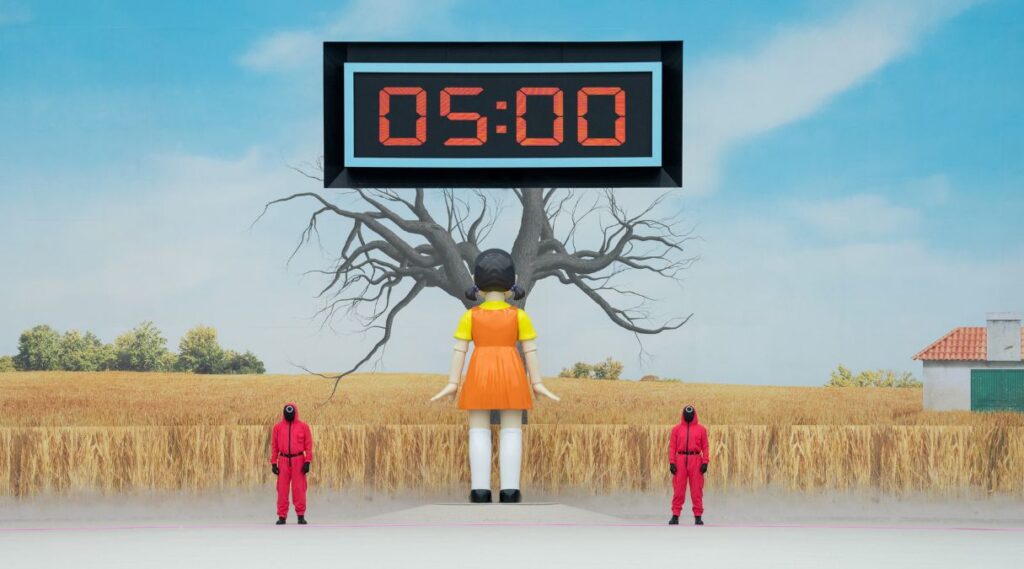Squid Game was a global phenomenon when it was released in September 2021. Focusing on a collection of poor, struggling individuals, the series struck a chord with viewers who became addicted to cheering their favorite characters on as they fought for not only enough money to change their lives but life itself, as elimination from a game meant death. Looking to cash in on the popularity of that series, Squid Game The Challenge begins a real-life competition as players overcome challenges and each other as they compete for up to 4.6 million dollars.
While there is a surprising number of upsides to Squid Game The Challenge I want to dive into, I feel I must address the obvious squid in the room. When Netflix first announced the concept of basing a real-life game show on a fictional concept that forced desperate people to kill each other for the amusement of the rich, it struck many as a strong example of a complete lack of media literacy. This feeling doesn’t fade as you watch through the first five episodes of the series.
Squid Game The Challenge opens with the iconic Red Light, Green Light Game, where players who are caught moving have an ink pack explode in their shirt, simulating being shot just like in the original show. Players even fall over, feigning death, adding to the uncomfortable reminder of what the source material was all about.
While the blood pack/dying routine continues to be used through the second game, it quickly vanishes after that, leaving the viewer wondering if someone halfway through production decided this is in bad taste and scrapped it. Once that is removed from the series, the awkward feeling never fully leaves but becomes much more bearable.
Squid Game The Challenge adds a social dynamic to the formula.

Moving on from there, Squid Game The Challenge actually creates an interesting series that keeps both the contestants, as well as the viewers, on their toes. While the first game is a carbon copy of the game from the original, the second challenge, Cookie, adds a new spin that forces added social dynamics into the game, causing a heightened sense of drama beyond the core task. From there, the series introduces entirely new events for the players to participate in, creating a sense of the unknown whose gradual introduction makes it far more effective than just not knowing from the get-go.
In addition to the larger challenges are tests that are administered while the participants are in their dorm space. These tests generally see one or more players getting to choose others to be eliminated from the game for whatever reason they choose. These tests utilize interesting rules to create situations that, at first glance, feel fine, but things become more complex only when intricacies are introduced.
One game has the players line up and punch in the number of who they want to be eliminated, with the three highest vote-getters forced to leave. However, the first time someone enters a number, it appears on a jumbo screen on the wall. So, entering a player’s number for the first time puts a target on the chooser’s back. These unexpected turns create interesting social experiments that can be genuinely intriguing to see their effects play out.
The drawback for many to this setup will be the obvious effect it has on a large number of the players. While reality competitions tend to bring out the worst in many, Squid Game The Challenge feels like it goes far more out of its way to encourage the less desirable attitudes to come out, as opposed to simply giving them the opportunity to do so. Due to the prize money growing as players are eliminated, contestants are encouraged to view eliminating others as a good thing, rather than a necessary one. This influence shines brightest during some of the 1:1 interviews where players are seen to embrace this outlook, going so far as to refer to their fellow contests as simply money.

The other significant thing about the series’ choice of games is that it feels like who gets knocked out is far more up to chance or the whims of other players than any amount of skill or ability. Some players are voted out because they are seen as a threat to someone, and others are voted out because a player was tricked into a position where they had to vote someone out, so they choose someone that they think won’t garner their backlash. While I can see this feeling of randomness ungratifying to many, I can also see the core reality audience perhaps enjoying the mystery, especially if they can typically spot a winner early on.
Another element of the production that helps the series truly pull the viewer in is how well it obfuscates who is going to get knocked out. Players who get lots of attention on camera and in interview segments often go out earlier than you would expect. By the end of episode two, I had completely given up on guessing who would be likely to make it to the next credits sequence.
The final element of Squid Game The Challenge is the visual production. The original setting has been recreated in painstaking detail, and even the new elements feel right at home within the environment. The camera work also does an expert job of heightening the tension throughout the series, as it times close-ups, crowd reactions, and surprise reveals wonderfully. Accompanying these visuals are excellent musical choices that further work to build up the stress and tension of the series.
Squid Game The Challenge delivers a captivating, if chaotic, set of episodes. If you can move past the awkwardness of its core concept, the series delivers a lot of the drama, tension, and backstabbing that reality tv has always been known for.
Squid Game: The Challenge is streaming now on Netflix.
Follow Our Squid Game Coverage
Season 1 | Season 2| Season 3 |
Squid Game: The Challenge
-
Rating - 8/108/10
TL;DR
Squid Game: The Challenge delivers a captivating, if chaotic, set of episodes. If you can move past the awkwardness of its core concept, the series delivers a lot of the drama, tension, and backstabbing that reality tv has always been known for.








